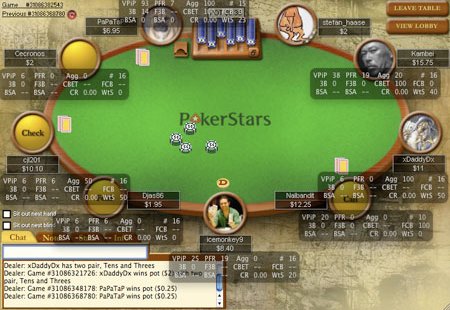Member Comments
No comments so far
 There are many poker programs available that produce a Heads-Up Display (HUD), which gives a player an immediately updated set of statistics on themselves and opponents at an online poker table. In this edition of “What’s in your HUD?” we’re going to take a look at High-Stakes No Limit Hold’em players and see what’s in the HUD of several popular poker instructors. The answer just might be a little surprising.
There are many poker programs available that produce a Heads-Up Display (HUD), which gives a player an immediately updated set of statistics on themselves and opponents at an online poker table. In this edition of “What’s in your HUD?” we’re going to take a look at High-Stakes No Limit Hold’em players and see what’s in the HUD of several popular poker instructors. The answer just might be a little surprising.
The first player we found was instructor Cole South, who produces videos for both StoxPoker and CardRunners. He released a $25-$50 No Limit Hold’em video playing both heads-up and six-max tables earlier this year. His HUD is extremely thin and almost looks like something a first-time noob would use, with just Voluntarily Put Money in the Pot (VPIP), Pre-flop Raise (PFR), Aggression Factor (AF), and Number of Hands. Overall, it’s a slimmed-down HUD that gives only the most basic stats. During the video, South clicked on the HUD to bring up the pop-up display a few times, which gave detailed stats. For the most part, though, he preferred to use his table reads and basic HUD stats to play these nosebleed states.
Nick “stoxtrader” Grudzien is one of the main instructors at Stox Poker. In 2008, he released a $10-$20 No Limit Hold’em Six-Max video and guess what? Yup – no HUD at all!
Another $10-$20 No Limit Hold’em player is Kyle “Cottonseed” Hendon, who produced a video of himself playing a year ago for Stox Poker. Similar to what we saw with South, the HUD was extremely slimmed-down for the six-max tables, with only VPIP, PFR, AF, and Hands Played. Many times through this video, Hendon would click on his HUD to bring up the pop-up window, which would have more detailed stats showing when he needed them.
Dusty “Leatherass9” Schmidt is one of the head instructors at Stox Poker. You can often find him playing the 1,000nl tables ($5-$10 blinds) and he has posted solid win-rates at these stakes on both Full Tilt Poker and PokerStars. His HUD has a bit more information than the other guys, sharing VPIP, PFR, AF, and Hands. In addition, he has steal stats and folds to steal stats up on his HUD. For the most part, he doesn’t put too much stock into his HUD and, like the others, makes plenty of table reads to assist his play.
This gets us into a fundamental discuss about a Heads-Up Display at the high-stakes games. It appears that as you move up in stakes from the micro-stakes games, the HUD will evolve to include things like steal stats, fold to steal, 3bet, fold to 3bet, and more. As you play in the small-stakes games ($0.50-$1 to $1-$2), HUDs tend to include figures like street aggression (rather than total Aggression Factor) and even 4bet stats.
As you move up to the mid-stakes games, the HUD will again evolve and more than anything, expected ranges for those same stats will alter. As you arrive up to the high-stakes games, the HUD becomes a little less meaningful because the player pool there is so small. Due to playing the same people over and over, the game is more about meta-strategy against specific opponents. Because play will be erratic and unpredictable, the HUD loses its value.
Of course, don’t tell this to Alan “Dixon01” Jackson, another instructor over at Stox Poker. Although he has played in some of the high-stakes games, he primarily plays $2-$4 and $3-$6 No Limit Hold’em. For anyone who has seen his videos, his HUD is one of the most ridiculous things in all of online poker. Stats on his HUD include 3bet, fold to 3bet, 4bet, fold to 4bet, flop cbet, fold to turn raise, fold to re-raise, VPIP, PFR, Steal, limp-call, cbet, flop call, raise cbet, went to showdown, and more. It’s easily the most confusing thing to see for someone new to online poker, but whatever he’s doing with his HUD, it’s working for him.
So as we’ve seen in our examples, for most of the high-stakes players, the HUD is more of an afterthought. Most of the stats are hidden in the pop-up, which are only seen when clicked on; most high stakes players use a very simple HUD.
No comments so far